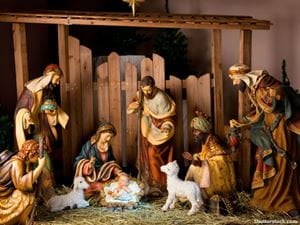
Many of us are intensely familiar with the traditional nativity story, but are you aware of the common misconceptions enshrined in popular depictions of Jesus’ birth?
The U.K.-based Bible Society conducted a survey a few years back about these very details, finding that, in Britain, “99% of adults fail to recognize the traditional nativity story from commonly held misconceptions about donkeys, stables and inns.” And a recent LifeWay survey found just 22% of Americans can accurately tell the nativity story.
As it turns out, it’s quite easy to get some of the details wrong, especially if our knowledge of Christ’s birth is colored more by the nativity displays and images we’re accustomed to seeing during the Christmas season than on the Bible.
So, let’s briefly explore some of the most commonly-held misconceptions:
1) There were three wise men who visited Jesus: While many nativity scenes and stories present us with three wise men, the Bible never actually tells us how many of these individuals came to see Christ. We do know, though, that three gifts were given: gold, frankincense, and myrrh. Still, that doesn’t mean there were definitively three individuals who gave them.
2) The wise men arrived right after Jesus’ birth: Contrary to popular depiction — and belief — the wisemen didn’t necessarily arrive to meet Jesus right after his birth. As TheBlaze previously reported, Matthew 2 seems to indicate they visited Jesus in a “house,” with the Bible also noting that King Herod ordered all kids under age two killed — something that indicates Christ might have been a bit older than a mere infant when the order was given.
Thus, the wise men were quite possibly not, as is often shown, standing over the newborn Christ’s manger.
3) Mary traveled to Bethlehem on a donkey or camel: Nativity stories often show Mary riding on a donkey or camel as she traveled with Joseph to Bethlehem, but, in reality, the Bible doesn’t tell us how she made that journey. Considering it was a long trek and she was presumably quite pregnant, it’s possible — even likely — that she traveled atop an animal, though being too definitive about that scenario isn’t really possible based on the information provided.
4) Jesus was definitively born on Dec. 25: The truth is, we have no idea when Jesus was truly born. Experts have different ideas about when the monumental event unfolded, but most agree on one thing: we can’t know for sure when it happened. Obviously, Dec. 25, has become the official date we commemorate the Christian savior’s birth. You can find out more about how we arrived at this date here, but caution: the history is anything but settled.
5) Mary gave birth the night she arrived in Bethlehem: We don’t know how long Mary was in Bethlehem before giving birth, though many traditional depictions of the nativity story make it seem as though Jesus’ birth happened on her first night in town. Consider that Luke 2:6-7 reads, “While they were there, the time came for the baby to be born, and she gave birth to her firstborn, a son. She wrapped him in cloths and placed him in a manger, because there was no guest room available for them.”
6) Jesus’ manger was surrounded by farm animals: It’s not uncommon for nativity scenes to feature various animals handing out around Jesus inside of a barn or a similar area — the apparent site of Christ’s birth, though GotQuestions.org notes that “the Bible never mentions whether or not animals were present — in fact, it never even mentions a stable.”
These are just a few of the potential misconceptions surrounding the Christmas story. Of course, none of them take away from the true meaning of Christmas – that never changes.
Merry Christmas!

